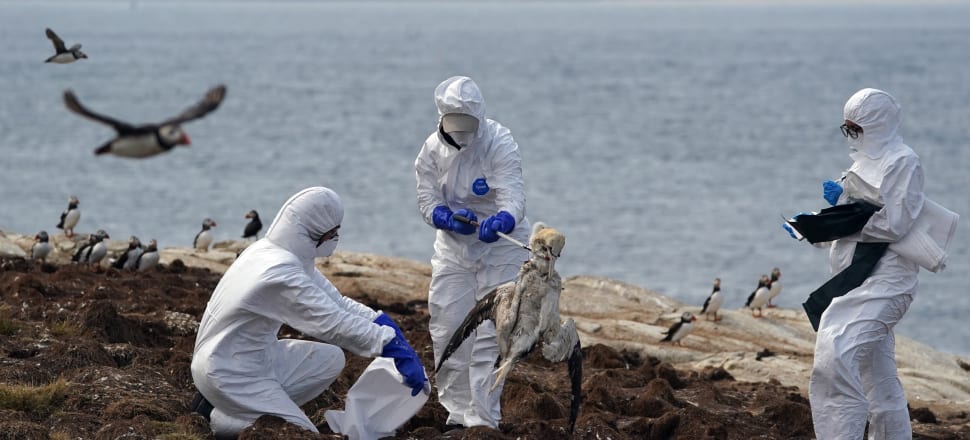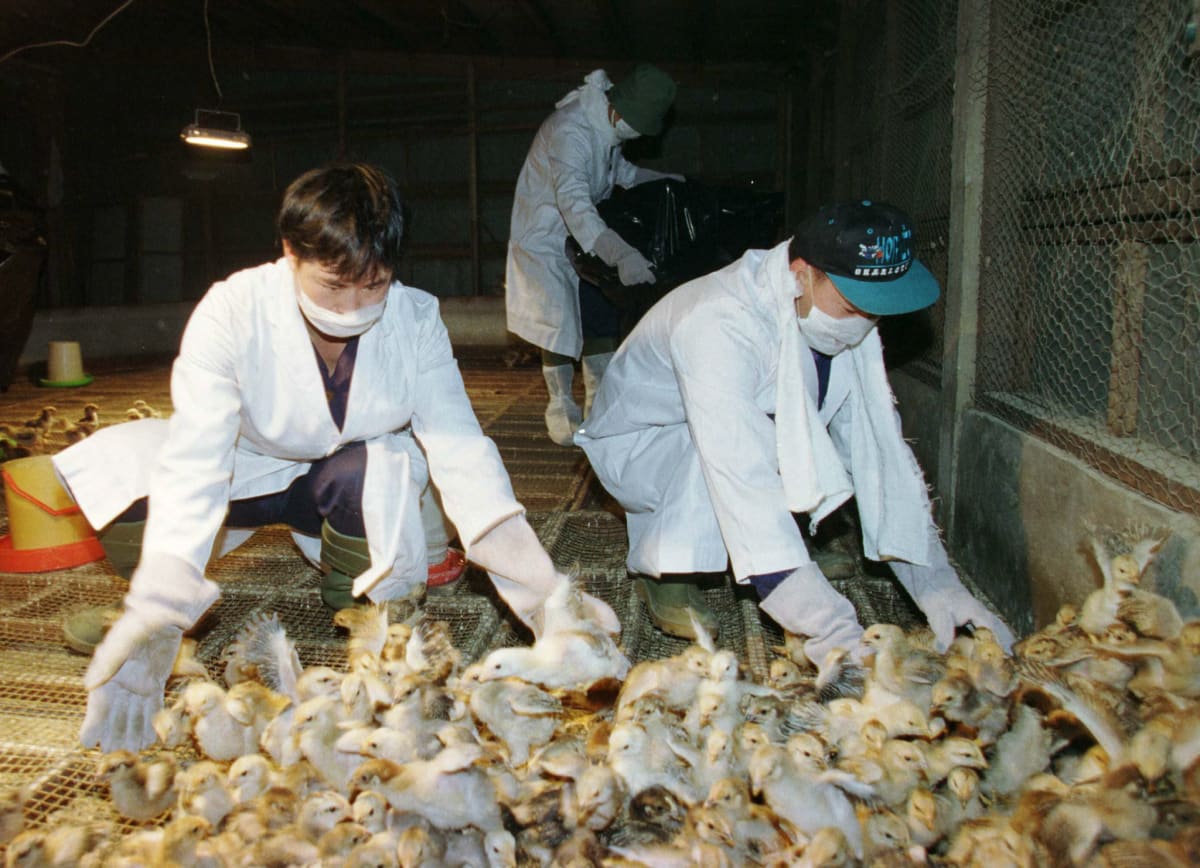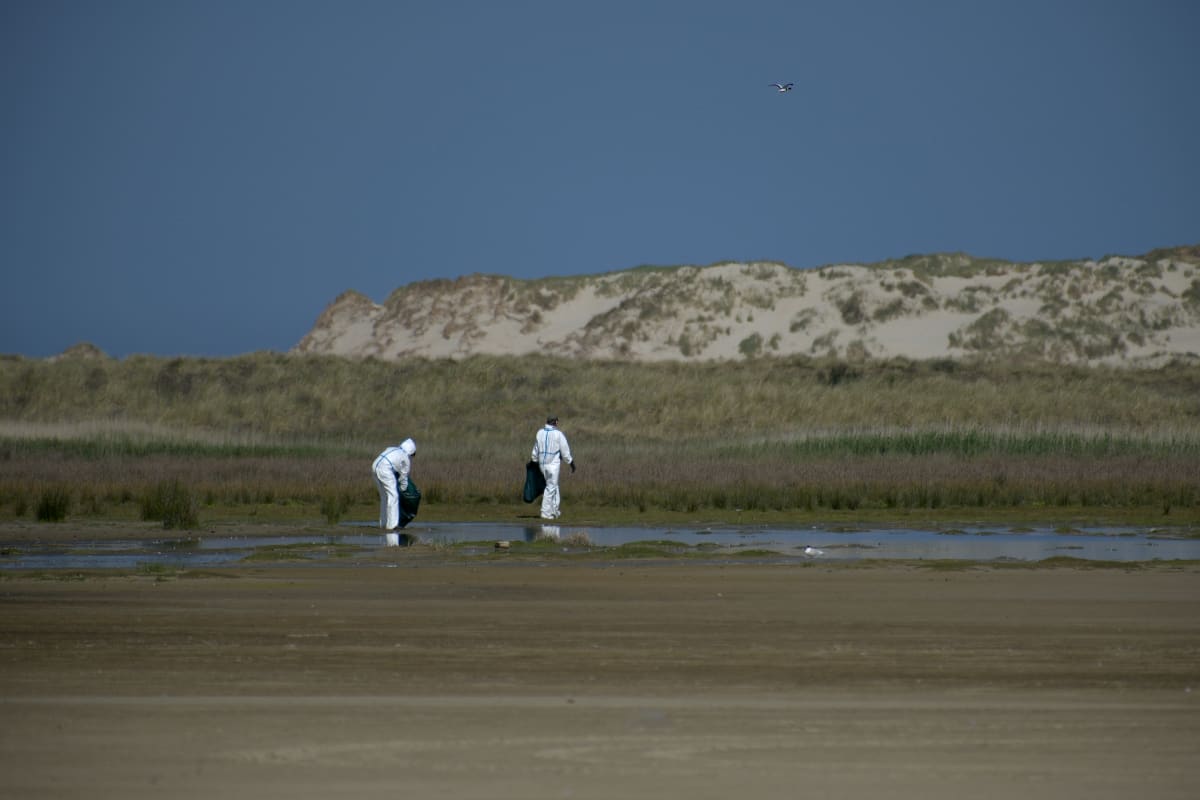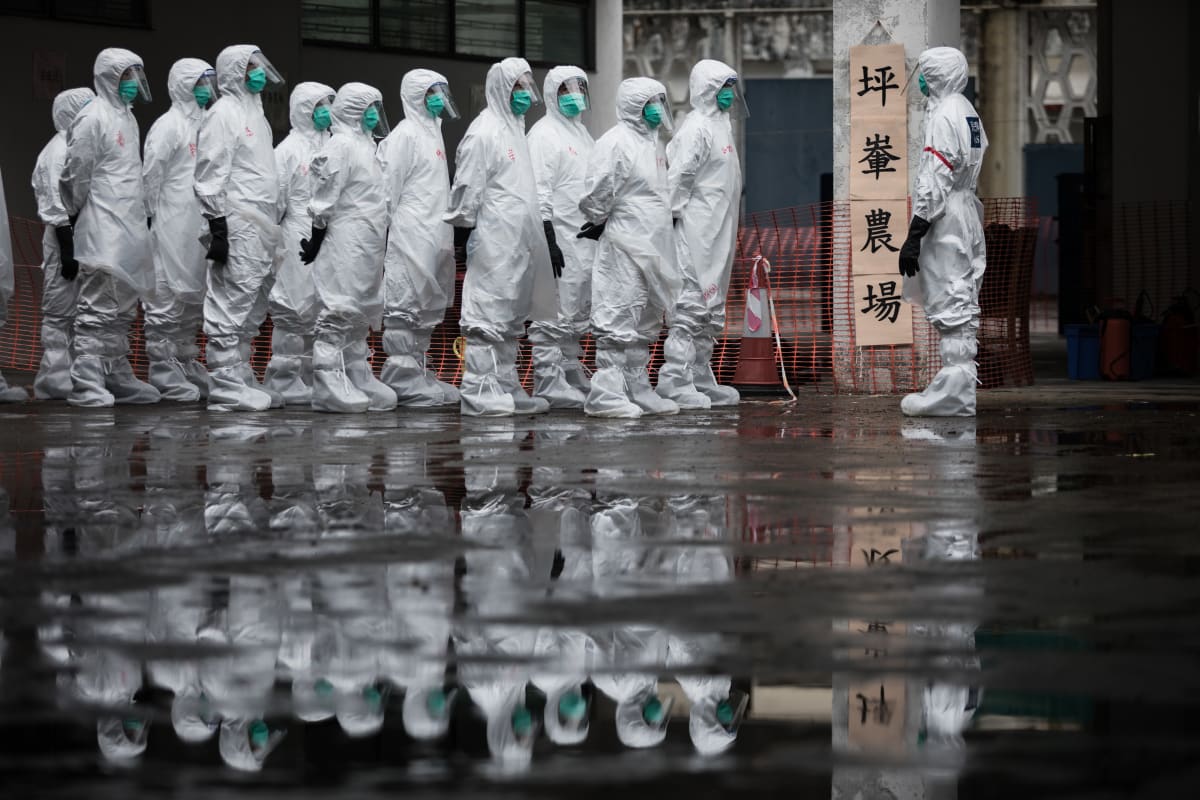
H5N1 only sporadically infects humans - but it kills half of those who catch it. As the largest ever outbreak of the virus continues to rage, is New Zealand prepared?
Special report: Kiwi scientist Robert Webster knew two things about the avian flu virus he dripped into his nose one day in late 1997: It was almost totally lethal to poultry and it had killed the only human known to have been infected with it.
Fortunately for Webster, the H5N1 virus he was inhaling had been killed with formalin and turned into a rough-and-ready concentrated vaccine. He, as well as a handful of other researchers who took the makeshift vaccine after waiting a day to ensure Webster suffered no side effects, needed the immunisation ahead of venturing into ground zero of a novel pathogen outbreak.
There are a lot of similarities between the origin stories of the Covid-19 pandemic and H5N1 influenza in humans. They both burst into public consciousness in east Asia, linked to sickness in live animal markets.
There are a few differences as well, but the most important one is this: Covid-19 killed one in 28 known cases in Wuhan in early 2020, but H5N1 kills one in every two.
READ MORE: * NZ wasn't ready for a pandemic * Beating the next pandemic without a lockdown
As the world enters the third year of the worst ever outbreak of H5N1, Webster is among a series of experts raising the alarm that we need to be prepared for the worst case scenario - another pandemic.
Speaking to Newsroom from his office in the Department of Virology at St Jude Children's Hospital in Tennessee, he says our saving grace is that H5N1 is not yet well-adapted to humans. While it struggles to move from human to human, it has made the jump from wildlife into humans on dozens of occasions over the past two decades - the World Health Organisation has recorded 868 cases since 2003, of which 457 have died.
The situation is getting worse, too. Last year, H5N1 was found spreading rapidly on a mink farm in Spain. That's the first evidence of unhindered transmission between mammals outside of the lab.
"The possibility is there," Webster says, of the virus adapting to similarly spread between people.
"I personally am quite concerned. This virus has tremendous capacity to acquire new genes, new mutations, and if it could spread easily between humans, it would be a catastrophe."
A panzootic
Prior to Covid-19, there were frequent warnings about the potential for a pandemic. But most researchers weren't looking at bat coronaviruses - they were worried about influenza.
"Avian flu never went away, it just bubbled along – that’s not a technical term, but it just carried along. Obviously concern shifted to Covid-19, but we need to go back to influenza," University of Otago epidemiologist Michael Baker says.
That concern is partly why Webster dropped everything in November 1997 when he got a call from the head of the Influenza Branch at the United States Centres for Disease Control about six cases of severe influenza in Hong Kong. Three were in intensive care, one was already dead.
"This is certainly the largest outbreak of H5N1, probably in most countries in the world," Webster says.
He called on a team of young scientists to join him in Hong Kong, where they quickly confirmed the virus was H5N1. The strain was known to Webster from the previous year, when outbreaks on Chinese poultry farms had killed between 70 and 100 percent of chickens. In May of 1997, the first human case was reported in a boy in Hong Kong, who died five days after admission to hospital.
It took a while for researchers to determine that the virus that had killed the boy was H5N1, since there had never been a case of animal influenza infecting humans. Efforts to match virus samples from the boy against human samples held in Hong Kong and in Atlanta, where the CDC is based, were unsuccessful. Ultimately, scientists came to Webster in Tennessee, because he'd amassed a collection of antisera for all known influenza viruses.
That was how the H5N1 connection was discovered. It put Webster on high enough alert that he purchased a next-day ticket to Hong Kong after receiving the call from the CDC in November 1997.
After lengthy testing efforts, which included injecting influenza samples into fertile chicken eggs and a brief return to Memphis for genomic sequencing, Webster and his team matched up the new human influenza cases with H5N1 strains that were widespread at live bird markets in Hong Kong.
The city culled its 1.3 million chickens from more than 100 live bird markets in two days. Then the markets were cleaned and disinfected and strict new biosecurity protocols were introduced when they reopened. H5N1 was kept out of the city for nearly two years, before an incursion in waterfowl markets prompted the government to mandate all ducks and geese be sold after processing and chilling.

Poultry markets were free of the virus until 2001, when another cull was implemented.
Since then, however, H5N1 has spread to much of the rest of the world in successive waves. That's because it is endemic in migratory birds, particularly ducks, which seem to be completely unaffected by most strains of the virus. They then transmit it to other migratory species and domesticated poultry - alongside occasional spillovers into mammals.
Globally, the situation today is worse than ever before.
"This is certainly the largest outbreak of H5N1, probably in most countries in the world," Webster says.
Other experts have called it a panzootic - a pandemic among animals. In the United States, 1.5 million chickens have died of the virus in the latest outbreak and nearly 60 million have been culled to fight it.
The global toll of the disease and culling has topped 150 million birds, including 50 million in Europe and the UK and 10 million in Japan.
And that's just in domesticated animals.
"The fact that there is a virus that can transmit mink-to-mink suggests that there is a possibility that it could transmit among us," Webster says.
"In the last two years there has been an unprecedented mortality of wild birds throughout the Northern Hemisphere due to the avian influenza virus," Brett Gartrell, a professor of wildlife health at Massey University, says.
"During this period, over 400,000 dead birds have been recorded from over 2600 separate mortality clusters in wild bird populations; however, the actual number of birds affected is estimated to be much higher. Deaths due to this strain of the virus have been reported from almost every country in Europe, in North and South America and Northern Africa."
It's also increasingly spilling over into mammal populations.
"It has transmitted to many, many mammals. You name it: Bears, sea mammals, tigers, foxes," Webster says.
In lab experiments, scientists have managed to make an H5N1 strain that spreads between ferrets, which are a good proxy for human-to-human transmission. The Spanish mink farm outbreak shows the virus can get there on its own too.
"The fact that there is a virus that can transmit mink-to-mink suggests that there is a possibility that it could transmit among us," Webster says.
Animal incursions
The worsening global situation raises important questions for New Zealand and how we would respond to two H5N1 scenarios - either its arrival in our birds or the development of a strain capable of transmitting between humans, which sparks a new pandemic.
In the first situation, Biosecurity New Zealand within the Ministry for Primary Industries would be the lead on the response.
Mary van Andel is Biosecurity NZ's chief veterinary officer and she says we already have systems in place to detect H5N1 or any other severe avian influenza viruses.
Every summer, biosecurity officials descend on hunting grounds near migratory bird sites across the country. There, they capture and take samples from more than 1000 ducks and test them for influenza. Throughout the year, birds admitted to wildlife hospitals are also tested if there's a suspicion of influenza. And public reports are also taken in - all 20 avian mortality reports from last year tested negative for influenza.
So far, neither H5N1 nor any other high pathogenicity avian influenza (HPAI) has been detected in New Zealand.
The good news is that van Andel thinks the chance of a wild introduction via a migratory bird is low.

"We are isolated from other land masses, do not have migratory waterfowl pathways and have strong border biosecurity," she says.
"A variety of migratory shorebirds and seabirds travel a long distance to return to New Zealand each spring, but due to the high mortality of HPAI viruses like H5N1, the risk for live infected species making the journey to arrive here is considered low. Together with DoC, Biosecurity New Zealand has sent AI screening kits to the Subantarctic Islands for testing to support reporting in case unusual mortality events are detected there."
So the birds that do come here are likely to die of the virus before they arrive and the birds that are resistant to the virus (ducks) don't travel here from anywhere other than, rarely, Australia. There have only been two Northern Hemisphere duck species identified in New Zealand in the past 150 years, according to the Department of Conservation, and these likely came from Hawaii rather than North America, Asia or Europe.
On the domesticated side of things, live poultry isn't imported into New Zealand. The industry body works with biosecurity officials to monitor the health of farmed chickens. Any live exports are tested for HPAI.
Baker is reassured by these steps and thinks a migratory introduction is unlikely.
"It will fly into New Zealand, but it will fly inside an aircraft, it won’t be flapping its wings," he says. The appropriate response if the virus were detected among domesticated birds here would be culling, he adds, which was successful when overseen by Webster in Hong Kong in the 1990s.
"If the disease enters the country, it may move around the country in wild birds and traded poultry unless it is quickly eradicated. In a recent outbreak of a pathogenic avian influenza H7N7 strain in Australia, control and eradication were achieved by culling over 433,000 birds, including poultry, turkey, farmed emus, and pet birds," Gartrell adds.
"MPI would likely adopt a similar eradication strategy to prevent the virus from becoming established in New Zealand, however, it is not clear how this control strategy would be applied to wildlife populations. Early detection, reporting, containment and biosecurity measures will be important in trying to stamp out the disease to prevent further spread."
Van Andel says her response would depend heavily on the context, though movement restrictions, vaccination and culling were all on the table. The end goal would be to eliminate the virus.
"If an HPAI virus was detected in New Zealand, the World Organisation for Animal Health (WOAH) and our trading partners would be informed, and we would work with the relevant industry bodies and other government organisations on elimination," she says.
"The practices of culling wild birds and the destruction or modification of their habitat (e.g. wetlands, water bodies) have been deemed as ineffective measures for avian influenza control by global advisory organisations FAO (United Nations Food and Agriculture Organisation) and WOAH."
An H5N1 pandemic
As worrying as an animal introduction might be, the scenario that keeps Baker and Webster up at night is pandemic H5N1.
The Government's influenza pandemic plan says we should be able to avoid relying on mass graves, but that some people may need to be buried unembalmed in body bags rather than caskets.
In that case, the Ministry of Health and Health New Zealand/Te Whatu Ora would lead the response.
Right now, surveillance is conducted as part of routine infectious disease testing. That includes hospital-based testing, the Southern Hemisphere Influenza Vaccine Effectiveness Research Surveillance Project (SHIVERS), Flu-tracking and community virus surveillance.
"Together, these surveillance systems provide a robust understanding of the burden of disease due to respiratory viruses. The systems are also designed to provide for early detection of non-seasonal influenza viruses such as Influenza H5N1," a spokesperson for the health ministry says.
It would take two working days after receiving a sample for ESR to confirm an H5N1 influenza result. This would spark a series of events, including a phone call to Andrew Old, head of the Public Health Agency, and the activation of the 2017 Influenza Pandemic Plan.
Matt Hannant, the interim director of outbreak response in the National Public Health Service within Health NZ says the pandemic plan would be the basis of the response.
"At Te Whatu Ora, we are well positioned to respond if an infectious disease enters into Aotearoa," he says. "Te Whatu Ora has significant experience in managing diseases transmitted by the respiratory route through responding to Covid-19."
That pandemic plan makes for grim reading. It assumes a strain of similar lethality to the 1918 influenza pandemic. That's around 2 percent of infections ending in death, significantly higher than Covid-19 but much, much lower than the current 52 percent fatality rate of H5N1.
Modelling based on that 1918-esque scenario sees around two million people sickened over an eight-week period, peaking at 1.5 million active cases in weeks three to five. Just under 40,000 people would die, including 23,500 in the peak week. That's 40 times greater mortality than an average week and 25 times greater than the record week for deaths in New Zealand (which came during the BA.5 Covid-19 wave in July last year).
The plan says we should be able to avoid relying on mass graves, but that some people may need to be buried unembalmed in body bags rather than caskets.
The sheer transmissibility of the virus means it will be hard to control, according to the plan, and the country would rapidly move from trying to keep influenza out to stamping it out to managing the impacts.

Baker says this is the failed response trialled by most of the rest of the world to Covid-19 and that we should attempt to eliminate a potential pandemic H5N1 if we can.
"Can we now abandon mitigation as our preferred option for flu pandemics? I think we can. I would say with avian influenza, as soon as you saw any evidence of human-to-human transmission, you would do anything to stamp it out," he says.
"The big argument is to stop these pandemics at source. Anyone who looked at the sequence of events with Covid-19 would think, well if instead of stopping it at the end of February, the Chinese had stopped it in mid-January or even in December the previous year, we'd be a lot better off."
Even if the pandemic virus isn't halted at the source, New Zealand should still adopt an elimination approach, Baker believes.
"The essentials of elimination are basically border management. A sub-category of elimination is exclusion. People often say elimination is reducing to zero, but it's also maintaining zero from the beginning."
The end game isn't particularly clear, other than waiting for vaccination to reduce the mortality burden. Flu vaccines are historically only about 50 percent effective on average and Baker thinks that pattern would hold for H5N1 as well.
"I think we would see history repeating itself with influenza vaccines only giving 50 percent protection, moderate protection against severe disease and illness," he says.
Webster has a different view about the ideal response - he thinks elimination is unlikely given the virus is still endemic in animal reservoirs. Instead, mass vaccination should be the start of the pandemic response.
In New Zealand, we have only a small store of 150,000 courses of a pre-pandemic H5N1 vaccine. The latest batch arrived in January and the Ministry of Health spokesperson says they are suited to a currently-circulating strain.
The pandemic plan says these vaccines would be distributed to healthcare workers, other essential workers and the most vulnerable New Zealanders.
"The pre-pandemic vaccine which we hold is expected to provide the best available vaccine-mediated protection against human disease from H5N1. We are not currently looking to acquire further vaccines," the spokesperson says.
They add that getting enough to immunise everyone in the country would take "several months" - an understatement, according to Webster.
"If the virus starts transmitting human-to-human and starts killing like it did in Hong Kong, there will not be vaccines available because the world will simply gobble them up," Webster says.
"The first step, if this virus does transmit human-to-human, is to get the country totally vaccinated against influenza using the current vaccine. It's not going to stop you from getting H5N1, but it may stop you from dying."







